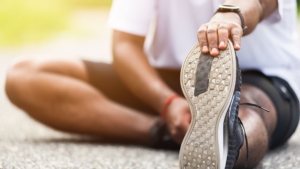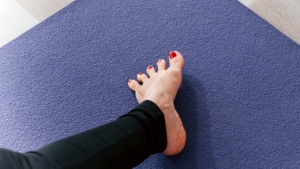Life has a funny way of throwing us curveballs. One minute you’re comfortably strolling through life, and the next, you’re hobbling around, cursing the pain in your foot. If you’ve landed on this page, there’s a good chance you’re familiar with this scenario. Morton’s Neuroma, the uninvited guest causing havoc in your foot, has probably disrupted your daily activities. But fear not, for there’s a silver lining to this painful cloud – exercise. Yes, you read that right. Simple exercises might just be the secret weapon in your battle against Morton’s Neuroma.
Table of Contents
No Sweat: Targeted Exercises for Relief
Now, before you start picturing strenuous workout sessions, let us clarify. We aren’t suggesting that you lace up your running shoes and start pounding the pavement. Instead, we’re talking about gentle, targeted exercises that can alleviate your foot pain and help you reclaim your life. These exercises aim to strengthen your foot muscles, improve your foot’s flexibility, and ultimately, reduce the pressure on the irritated nerve causing the pain.
Why Exercise: The Natural Approach
So, why exercise? Well, for starters, it’s a natural, non-invasive approach to managing your symptoms. There are no side effects, no recovery periods, and certainly no hefty medical bills. Plus, you can do these exercises at home, at a time that suits you. All you need is a few minutes each day and a commitment to consistency.
Beyond Symptom Relief: Towards Better Foot Health
But that’s not all. These Morton’s neuroma exercises not only help alleviate your current symptoms but also improve your overall foot health. By strengthening your foot muscles and enhancing flexibility, you’re giving your feet the best defense against future problems. After all, prevention is better than cure, right?
Understanding Morton’s Neuroma
Before we jump headlong into the world of exercises, it’s crucial to understand our adversary better. In this case, it’s Morton’s Neuroma, a foot condition that’s as unpleasant as it sounds.
Morton’s Neuroma, contrary to what its name might suggest, isn’t a true neuroma. Instead, it’s a perineural fibrosis, which in layman’s terms means it’s a thickening of the tissue around one of the nerves leading to your toes. It’s like an unwanted houseguest who overstays their welcome, causing all sorts of discomfort and inconvenience.
Typically, Morton’s Neuroma affects the area between the third and fourth toes. However, it can also occur between other toes, but this is less common. The thickened tissue compresses the nerve, leading to a host of unpleasant symptoms such as sharp, burning pain in the ball of your foot. It’s like walking on a hot coal, but without the thrill of a dare or the applause of a crowd.

Now, you might be wondering, why does this thickening occur? Well, that’s a question that has puzzled medical experts for a long time. While the exact cause remains shrouded in mystery, like the secret recipe of your grandma’s apple pie, several contributing factors have been identified.
Common Causes of Morton’s Neuroma
Firstly, wearing high heels or shoes with a tight toe box can contribute to the development of Morton’s Neuroma. These types of footwear place excessive pressure on the forefoot, compressing the toes and increasing the likelihood of nerve irritation. It seems that our fashionable stilettos might have a sinister side after all.
Secondly, engaging in high-impact sports such as jogging or running can also put you at risk. These activities place a significant amount of stress on the foot, potentially leading to nerve damage. But, before you ditch your running shoes, remember that with the right footwear and foot care measures, you can still enjoy your favorite sports without harming your feet.
Thirdly, certain foot conditions and deformities, such as bunions, hammertoes, high arches, or flat feet, can make you more susceptible to Morton’s Neuroma. These conditions can disrupt the natural balance and alignment of your foot, leading to excess pressure and stress on certain areas.
Symptoms of Morton’s Neuroma
As for symptoms, Morton’s Neuroma often starts as a tingling sensation in the toes, a bit like the pins and needles you feel when your foot falls asleep. This sensation may progress to a sharp, burning pain, often worsened by walking or standing. Some people also report feeling as if they’re standing on a pebble or a fold in their sock.

The Role of Exercise in Treating Morton’s Neuroma
It’s time to usher in the hero of our story – exercise. Yes, while exercise may typically conjure images of sweat-drenched gym sessions or lung-busting runs, in the realm of Morton’s Neuroma, it plays a much gentler, yet equally vital role. It’s more like a meditative yoga session, focusing on gentle movement, strength, and balance, rather than a grueling boot camp workout.
Alleviating Symptoms through Exercise
 Exercise, specifically those designed to stretch and strengthen your foot muscles, has been shown to significantly alleviate symptoms associated with Morton’s Neuroma. These exercises are like a soothing balm on an irritated nerve, reducing inflammation and providing relief from discomfort.
Exercise, specifically those designed to stretch and strengthen your foot muscles, has been shown to significantly alleviate symptoms associated with Morton’s Neuroma. These exercises are like a soothing balm on an irritated nerve, reducing inflammation and providing relief from discomfort.
So, how does exercise achieve this magic? When you engage in foot-focused exercises, you’re essentially working out the small muscles in your foot. This helps to improve support to the affected area, reduce pressure on the neuroma, and promote better foot function. It’s like oiling a creaky door hinge – with consistent care, the door starts to move more freely, and the creaky noise (or in this case, the pain) diminishes.
The Simplicity and Accessibility of Foot Exercises
Moreover, the beauty of these exercises lies in their simplicity and accessibility. There’s no need for fancy gym equipment or elaborate setups. All you need is a flat surface, a sturdy chair, and sometimes, an everyday object like a golf ball. Add to this the convenience of being able to do these exercises anywhere, anytime, and you have a low-cost, effective solution to managing your foot pain.
Supporting Research for Exercise Benefits
But don’t just take our word for it. Several studies support the effectiveness of these exercises, cementing their place in the Morton’s Neuroma management toolkit. According to one study, over 80% of patients who engaged in regular foot exercises reported a significant reduction in their symptoms. Now, that’s a statistic we can all get behind!
So, as you lace up those comfy trainers and prepare to give these exercises a whirl, remember this – your journey to a pain-free life is not a sprint, but a marathon. Progress might seem slow at times, but every small step takes you closer to your goal. With persistence, patience, and a little foot wiggling, you can show Morton’s Neuroma the exit door!
Exercises for Morton’s Neuroma
Now that we’ve established the power of exercise in your battle against Morton’s Neuroma, it’s time to get moving. But don’t worry, there’s no need to break a sweat or attempt challenging yoga poses. Instead, we’re going to focus on some simple, yet effective exercises that you can do from the comfort of your own home.
Let’s dive in, shall we?
- Toe Spread and Squeeze: This is a two-part exercise that works to improve the strength and flexibility of your toes. Start by spreading your toes as wide as possible. Hold this position for a few seconds before relaxing. Next, squeeze your toes together as if you’re trying to pick up a pencil from the floor. Repeat these two movements in sequence for about 10 times. Imagine your toes are engaging in a friendly game of tag, spreading out to avoid being ‘it,’ then huddling together to discuss their game plan.
- Toe Curls: Also known as “toe scrunches,” this exercise is all about strengthening your foot muscles. Start by placing a towel on the floor and positioning your foot at one end. Using your toes, try to scrunch up the towel and pull it towards you. This might seem challenging at first, but remember, practice makes perfect. After a few attempts, you’ll be scrunching like a pro!
- Calf Stretch: Tight calf muscles can increase the pressure on your foot, contributing to the discomfort caused by
 Morton’s Neuroma. This stretch helps to relieve that pressure. Stand at arm’s length from a wall, place your hands on the wall, and move one foot behind the other. Keep your back foot flat on the ground and lean forward until you feel a stretch in your calf muscle. Hold this position for about 30 seconds, then switch to the other leg.
Morton’s Neuroma. This stretch helps to relieve that pressure. Stand at arm’s length from a wall, place your hands on the wall, and move one foot behind the other. Keep your back foot flat on the ground and lean forward until you feel a stretch in your calf muscle. Hold this position for about 30 seconds, then switch to the other leg. - Plantar Fascia Stretch: This is another helpful stretch that targets the bottom of your foot, relieving tension and promoting flexibility. Sit on a chair and cross your affected foot over your knee. Using one hand, pull your toes back towards your shin until you feel a stretch along the bottom of your foot. Hold this position for about 30 seconds, then switch to the other foot if needed.
- Massage: While not an exercise per se, a gentle massage can work wonders in relieving Morton’s Neuroma symptoms. Use your fingers or a small ball (like a golf ball) to massage the bottom of your foot, paying special attention to the area between your toes. This can help to reduce inflammation, improve blood flow, and provide immediate relief from pain.
Remember, consistency is key when it comes to these exercises. Aim to perform them every day, or at least a few times a week. Start slowly and gradually increase the intensity as your strength and flexibility improve. As always, listen to your body and stop if any exercise causes pain.
Morton’s Neuroma Exercises to Avoid Surgery
 Surgery, while an effective treatment option for Morton’s Neuroma, is typically seen as a last resort. It’s like the emergency exit on a plane – there if you need it, but ideally, you’d rather keep those doors firmly shut. After all, surgery comes with its own set of risks and a recovery period that can sideline you from your daily activities.
Surgery, while an effective treatment option for Morton’s Neuroma, is typically seen as a last resort. It’s like the emergency exit on a plane – there if you need it, but ideally, you’d rather keep those doors firmly shut. After all, surgery comes with its own set of risks and a recovery period that can sideline you from your daily activities.
This is where exercise comes in, shining like a beacon of hope in the sometimes stormy sea of Morton’s Neuroma treatment options. By engaging in the exercises we’ve discussed, you’re giving your foot the best chance to heal naturally, potentially helping you avoid surgical intervention.
Foot Exercises: Your Personal Fitness Trainer
But how does this work, you ask? Well, think of these exercises as your foot’s personal fitness trainer. They’re there to strengthen your foot muscles, improve flexibility, and encourage proper foot alignment. This can relieve pressure on the neuroma, reduce inflammation, and ultimately, alleviate your symptoms.
Addressing Underlying Issues and Prevention
What’s more, these exercises can help address some of the underlying issues that may have contributed to your Morton’s Neuroma in the first place. For instance, by improving your foot’s strength and flexibility, you’re better equipped to handle high-impact activities and less likely to wear footwear that places excessive pressure on your forefoot.
Moreover, exercise offers a preventive approach, helping to maintain your foot health even after your symptoms have subsided. This can potentially ward off future flare-ups, keeping your feet in prime condition for the long haul.
A Word of Caution and the Importance of Combining Treatments
At this point, we’d like to add a word of caution. While exercise can significantly help manage Morton’s Neuroma symptoms, it’s not a magic bullet. It’s important to combine these exercises with other conservative treatment options, such as proper footwear, orthotics, and anti-inflammatory medications, as advised by your doctor.
Remember that every journey is unique. What works wonders for one person might not have the same effect for another. So, be patient, keep an open mind, and most importantly, stay positive. You’re taking active steps to manage your condition, and that in itself is a huge achievement.
Final Thoughts
As we conclude this comprehensive guide to Morton’s Neuroma exercises, we want to leave you with this final thought – you’re not alone in your journey. There are countless others walking the same path, and together, you can overcome this challenge and stride towards a future free of foot pain.
So, give those exercises a try, listen to your body, and remember, every step you take is a step in the right direction. Here’s to happy feet and a pain-free future!


 Morton’s Neuroma. This stretch helps to relieve that pressure. Stand at arm’s length from a wall, place your hands on the wall, and move one foot behind the other. Keep your back foot flat on the ground and lean forward until you feel a stretch in your calf muscle. Hold this position for about 30 seconds, then switch to the other leg.
Morton’s Neuroma. This stretch helps to relieve that pressure. Stand at arm’s length from a wall, place your hands on the wall, and move one foot behind the other. Keep your back foot flat on the ground and lean forward until you feel a stretch in your calf muscle. Hold this position for about 30 seconds, then switch to the other leg.


